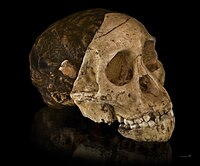cradle of humanity
The cradle of mankind is a metaphor for the region in which hominization took place, i.e. the biological evolution and the early cultural development of the homo genus . This idiom relates in particular to anatomically modern humans ( Homo sapiens ), but often also to their predecessor species such as Homo erectus and the australopithecines .
Even Charles Darwin had suggested in 1871 that man has in Africa developed since its closest relatives - chimpanzees and gorillas - are located there. Since 1924, when what was then the oldest fossil of a man's immediate ancestor was discovered in South Africa (the child of Taung ), numerous other fossil finds have contributed to the fact that Darwin's hypothesis is now considered to be very well supported and therefore Africa is considered by the paleoanthropologists to be the cradle of Humanity is considered. Important sites are in South Africa and along the Great Rift Valley , especially in Kenya , Tanzania and Ethiopia .
The oldest hominine finds outside of Africa are the fossils of Dmanisi , whose age has been dated to 1.75 to 1.8 million years.
Cradle of Humankind
| Sites of fossil hominids in South Africa | ||
|---|---|---|
|
UNESCO world heritage |
||
|
|
||
| National territory: |
|
|
| Type: | Culture | |
| Criteria : | (iii) (vi) | |
| Reference No .: | 915 | |
| UNESCO region : | Africa | |
| History of enrollment | ||
| Enrollment: | 1999 (session 23) | |
| Extension: | 2005 | |
As Cradle of Humankind ( Engl. For Cradle of Humankind ) the sites homininer fossils are some years South Africa referred. In particular, those sites are meant that are registered on the UNESCO World Heritage List . Around two million years ago, at least three hominine genera have been shown to live in this region : Australopithecus , Paranthropus and - as a representative of the Homo genus - Homo erectus , which is the most likely candidate for the direct predecessor of Homo sapiens .
In 1999, a 25,000 hectare site in the Witwatersrand Basin, about 50 kilometers northwest of Johannesburg in the Gauteng Province , was designated as a protected area. It includes 15 larger excavation sites with several hundred limestone caves in which numerous remains of fossil plants, animals and pre-humans have been found. Included are the caves of Sterkfontein and Swartkrans , the Wonder Cave and the Coopers Cave of Kromdraai as well as the Malapa Cave . Almost a third of all known pre-human fossils were discovered here.
In 2005, the World Heritage site was expanded to include the location of the first Australopithecus africanus fossil located around 300 kilometers from the core area near Taung in the north-west province and Makapansgat ( Makapan valley ) near Mokopane in the Limpopo province .
Since 2005 there has been a visitor center called Maropeng ( Setswana for return to our place of origin ) near the Sterkfontein Caves. The exterior of the building, partly designed as a barrow , offers space for exhibitions on the history of the earth, the formation of fossils and evolution; replicas of all the major hominine fossils are also shown.
The location of " Mrs. Ples " in Sterkfontein
Components of the world cultural heritage
| UNESCO ID | Official name | region | Coordinates | Area in hectares | comment | image |
|---|---|---|---|---|---|---|
| ZA-915-001 | Sterkfontein , Swartkrans , Kromdraai and the surrounding area | Gauteng | 25 ° 55 ′ 45 ″ S , 27 ° 47 ′ 20 ″ E | 25,000.00 |

|
|
| ZA-915-002 | Makapan Valley | Limpopo | 24 ° 9 ′ 31 ″ S , 29 ° 10 ′ 37 ″ E | 2,220.00 | World Heritage since 2005 |

|
| ZA-915-003 | Taung skull fossil site | northwest | 27 ° 37 ′ 10 ″ S , 24 ° 37 ′ 59 ″ E | 158.74 | World Heritage since 2005 |

|
See also
Web links
- Entry on the UNESCO World Heritage Center website ( English and French ).
- Website of the Cradle of Humankind (English)
- Visitor Center Maropeng (English)
Individual evidence
- ^ Charles Darwin: The Descent of Man, and Selection in Relation to Sex. London, John Murray, 1871, Volume 1, p. 199: “In each great region of the world the living mammals are closely related to the extinct species of the same region. It is therefore probable that Africa was formerly inhabited by extinct apes closely allied to the gorilla and chimpanzee; and as these two species are now man's nearest allies, it is somewhat more probable that our early progenitors lived on the African continent than elsewhere. "
-
^ Andy IR Herries et al .: Contemporaneity of Australopithecus, Paranthropus, and early Homo erectus in South Africa. In: Science. Volume 368, No. 6486, eaaw7293, doi: 10.1126 / science.aaw7293 .
Our direct human ancestor Homo erectus is older than we thought. On: eurekalert.org from April 2, 2020. - ^ Ann Gibbons: Great age suggested for South African hominids. In: Science , Volume 300, No. 5619, 2003, p. 562, doi: 10.1126 / science.300.5619.562
- ↑ Vanessa M. Hayes: Treasure Caves. In: Science , Volume 335, No. 6064, 2012, p. 40, DOI: 10.1126 / science.1211058
- ^ Fossil Hominid Sites of South Africa. whc.unesco.org, accessed May 3, 2015 .






